We’re living in a golden age for Real Betis.
The side from Seville finished the 2021/22 season in 5th place, their best campaign for 17 years. Not only achieving a consecutive Europa League qualification but storming all the way to the Copa del Rey final to clinch their first trophy since 2004/05. And all this from one of the most entertaining sides in Spain.
Led by the timeless Manuel Pellegrini, Los Verdiblancos racked up 100 goals in all competitions and exhibited some of La Liga’s most fluid attacking football.
After finishing just five points behind bitter rivals Sevilla, could Betis fans dream of going one better next season? Could they realistically land a Champions League place?
In this scout report, we’ll dive into what makes Betis so unique, dissecting their fluid tactical approach, and considering whether this system could take them even further next season.
Let’s begin with a tactical analysis of their philosophy and overall game plan, to see how they do things differently from everybody else.
Possession-based, attacking fluidity
There are two pillars to understanding Real Betis’ philosophy under Pellegrini:
1) Possession is important, but only for the sake of creating chances.
2) Attacking players have complete freedom of position in order to facilitate this.
These ideas are quite radically different to most top managers in the modern game. And they are reflected in even the broadest statistics.
In terms of possession, Betis averaged 54.1% last season, which despite being relatively high was eclipsed by six other teams. Sevilla, Real Sociedad and Celta Vigo all had higher possession on average.
But unlike these teams, who try to maintain possession at all costs, Betis are more direct and forward-thinking in their tactics. While they have a lower possession stat than those sides, they boast a higher xG total (55.2 in the league). In other words, they are happy to sacrifice control to create danger and unpredictability.
To see how these principles work in practice, let’s take a look at Betis’ shape, system and attacking movement.
Shape in possession: 4-2-3-1
Real Betis have a well-established basic shape which they have used all season.
On paper, it’s 4-2-3-1, as you can see below.
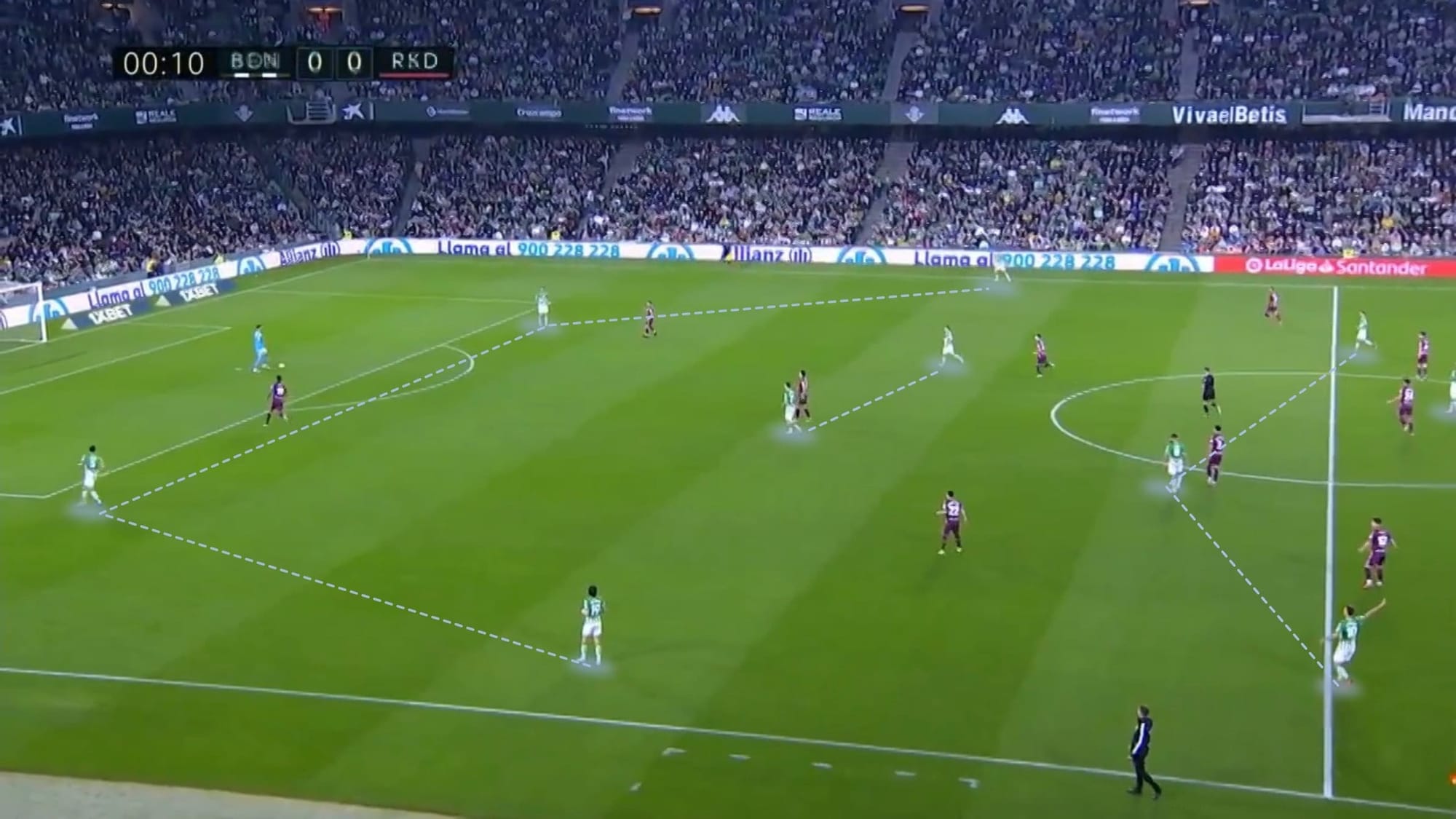
However, to reiterate, Pellegrini wants his team to be fluid and unpredictable. There are only a couple of aspects of the team that stay consistent throughout a game: the centre-backs and full-backs.
The full-backs are particularly important, as they always provide the width for this Betis side. Whether it’s in deep possession or further forward, both fullbacks use the full width of the pitch.
In the below example, it’s the first choice full-backs Héctor Bellerín and Alex Moreno keeping the width. If the opponents press high, a frequent option for Betis is to go diagonal to a full-back.
Betis make good use of keeper Claudio Bravo’s passing range to execute this.
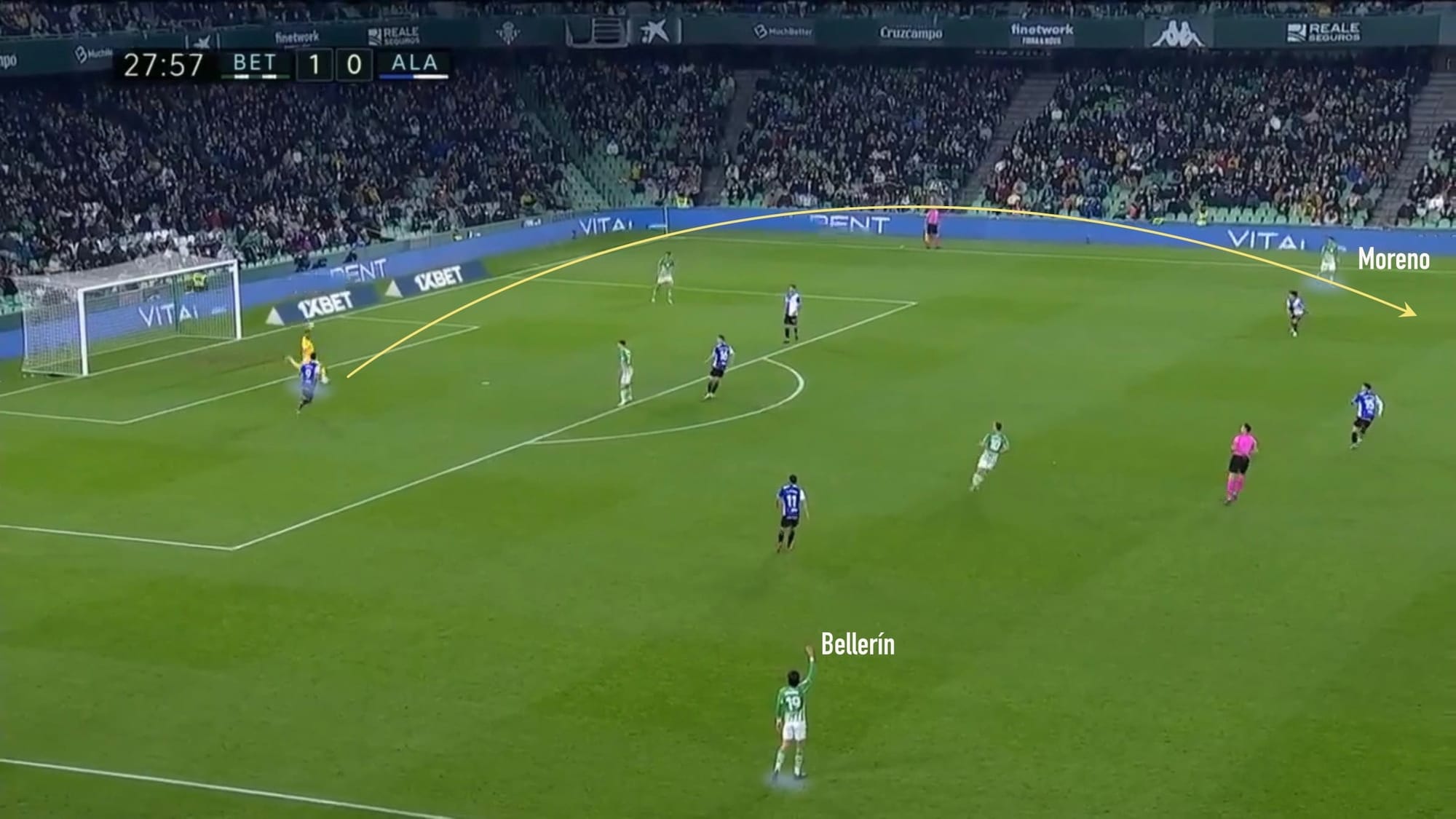
The same is true when Betis establish possession in the middle third. Here you can see the same two players more advanced, but still on the extremes of the pitch.
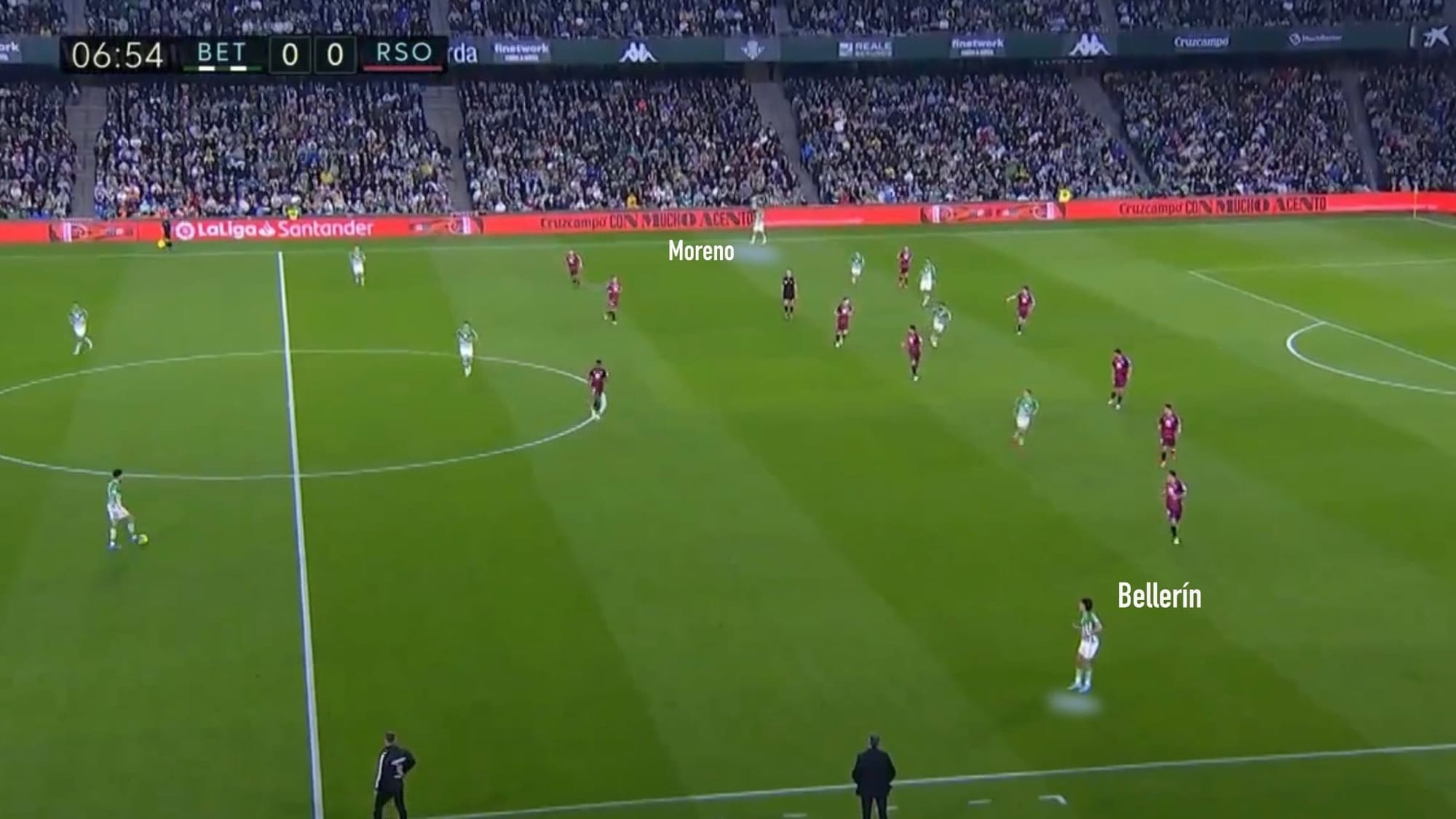
With the full-backs high and wide, the midfielders and forwards have the freedom of the middle of the pitch. How they operate is key to the analysis of what makes Betis so unique and so effective going forward.
To break down what’s going on, we’ll look at the team structure in two scenarios: building from the back, and attacking a medium-low block.
Buildup from defence
When the opposition presses high, Betis are excellent at finding ways out and quickly creating dangerous opportunities at the other end.
One reason for this is the position of the full-backs, which we’ve already talked about. By stretching the opposition press, Betis make it difficult to cover all the options, and the full-back becomes a regular out-ball.
But another important factor is Betis’ flexibility in these scenarios. Take the defensive midfielders as an example – here it’s Guido Rodríguez and William Carvalho. Often in the build-up, they are positioned close to each other, between the lines if possible, ready to give a passing option if one of them receives the ball.
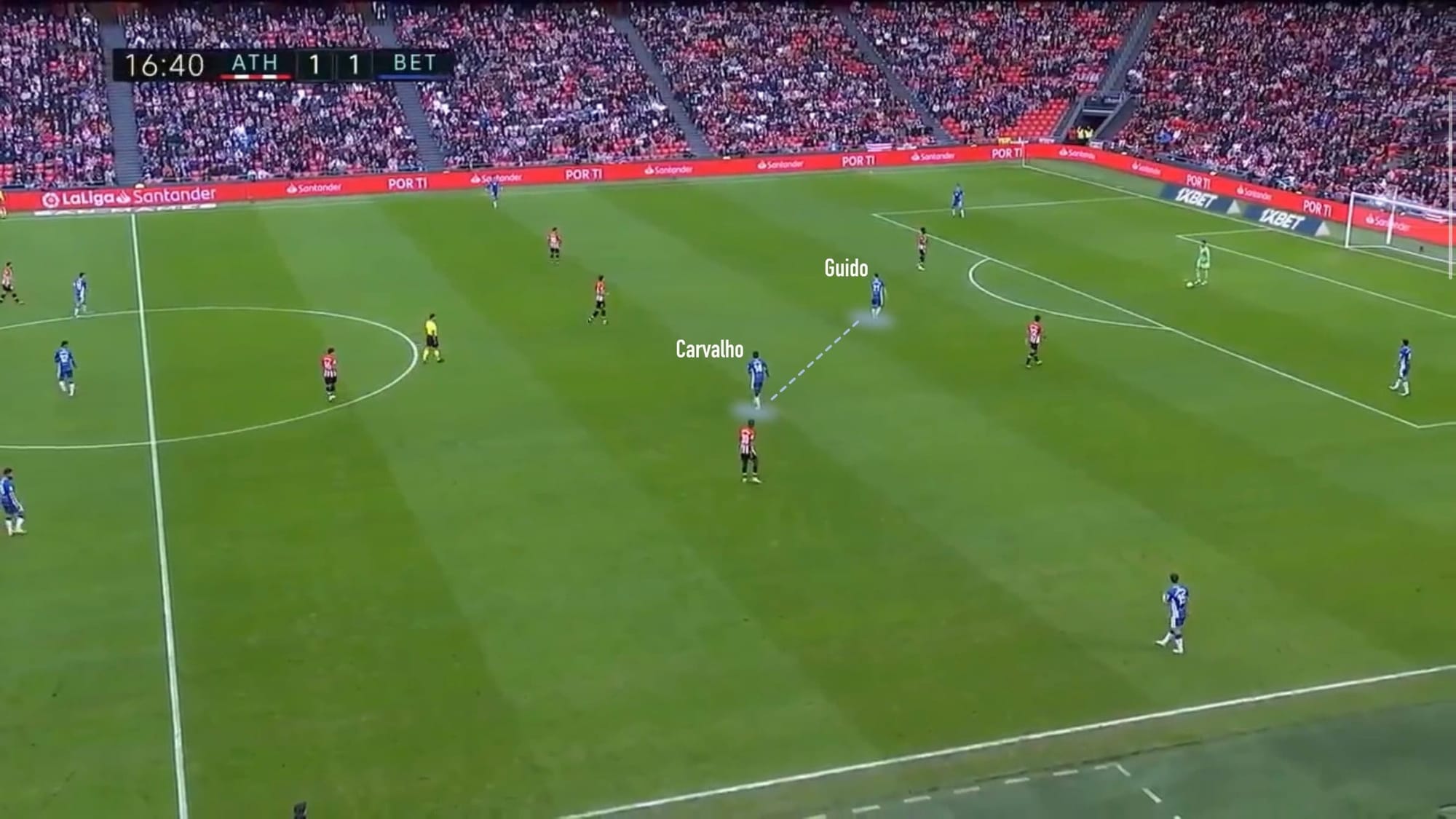
Because both full-backs are so wide, their central position is important, not just to prevent each other from being isolated, but in order to have numbers in the middle in case the ball is lost.
In this second example, however, the structure is completely different. Here, one of the pivots (Guido) drops between the centre backs. This would leave a single pivot in midfield, but for the roles of Betis’ two most important players: Nabil Fekir and Sergio Canales.

Here Canales (who is the right midfielder on paper) takes up a position close to Carvalho. Other times, Fekir (the attacking midfielder) will do this instead.
In Betis’ system, despite their starting positions on paper, Fekir and Canales have almost complete freedom of movement.
At any point during the build-up, one can drop deep and look for the ball to feet. The first major advantage of this is that it can completely disrupt the opponents pressing shape. Below, Canales wanders from high on the right to deep in midfield, creating a two vs one and an easy ball out of the press.
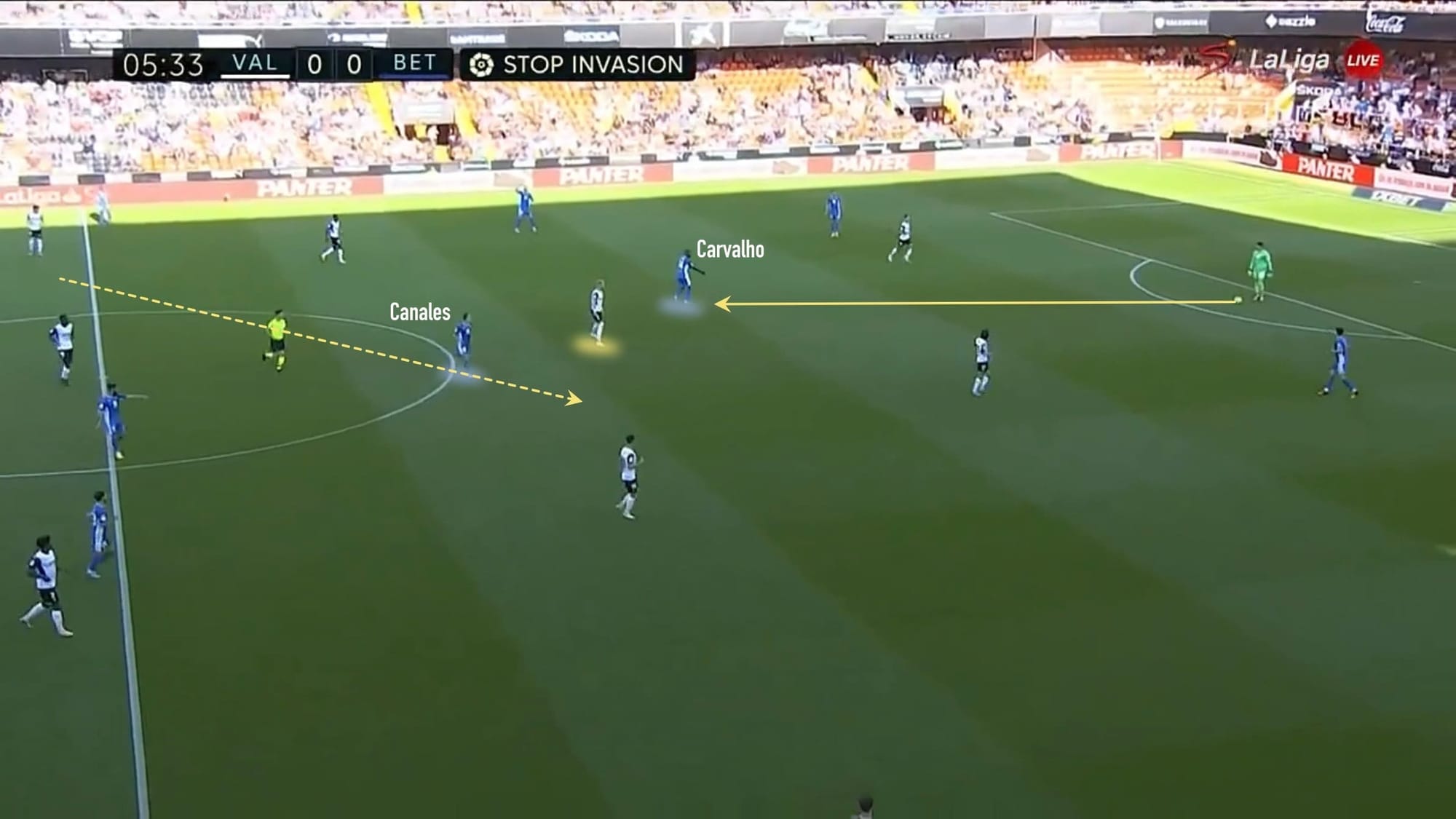
What is notable is the reaction from the other forwards when Canales drops deep. Rather than getting sucked towards the ball, they’ll often remain high up the pitch, usually in close proximity to each other. Canales (or Fekir) then has the option to move the ball quickly into a dangerous central area, where their team has another numerical advantage.
This is just moments after Canales has dropped deep. Carvalho turns and can play a threatening ball in behind.
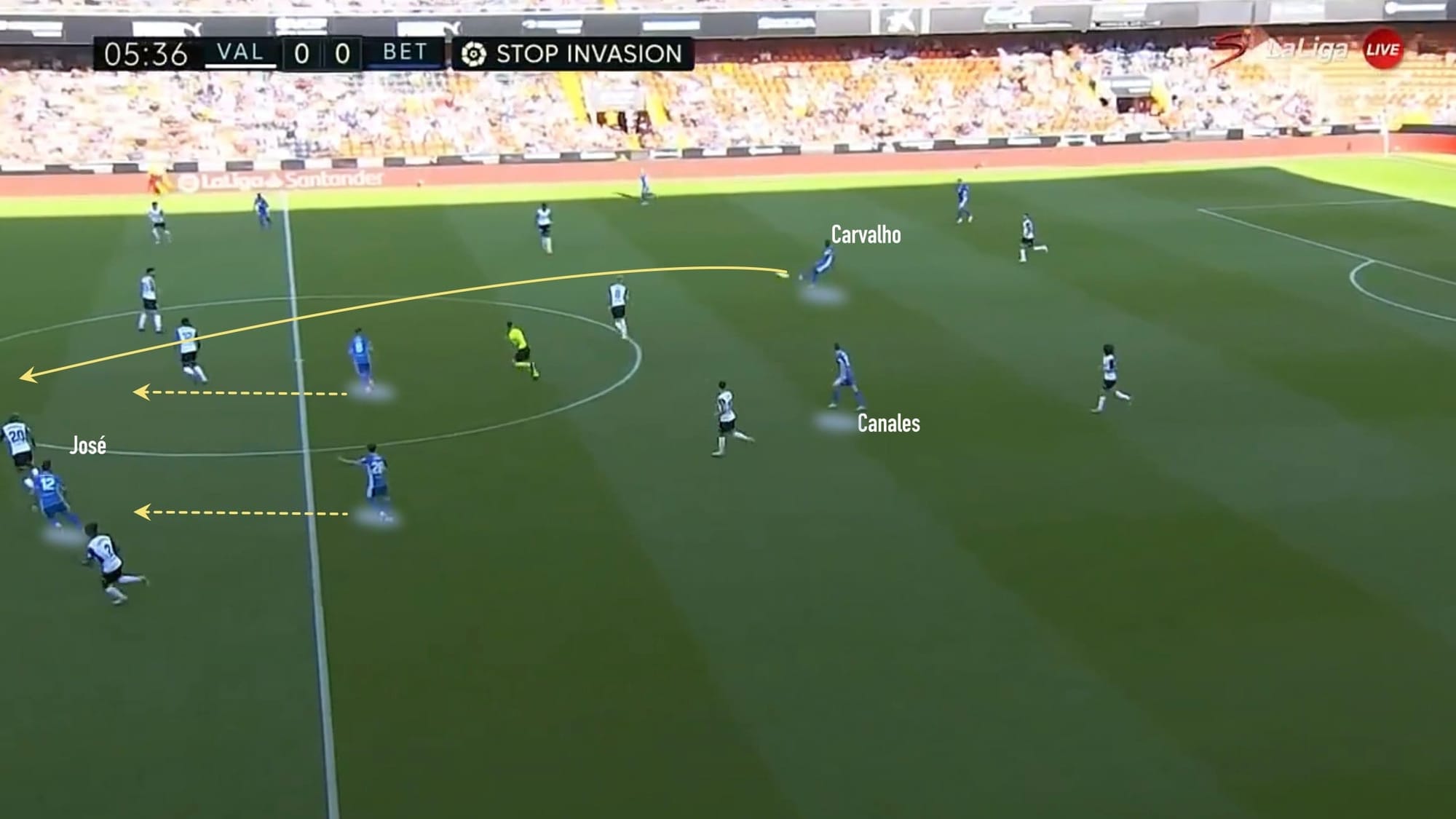
A quirk of this system is that it often creates an unusually big gap between Betis’ midfield and attack. They trust their defensive shape to play out of these scenarios and exploit the fact that they have a lot of players already in advanced positions.
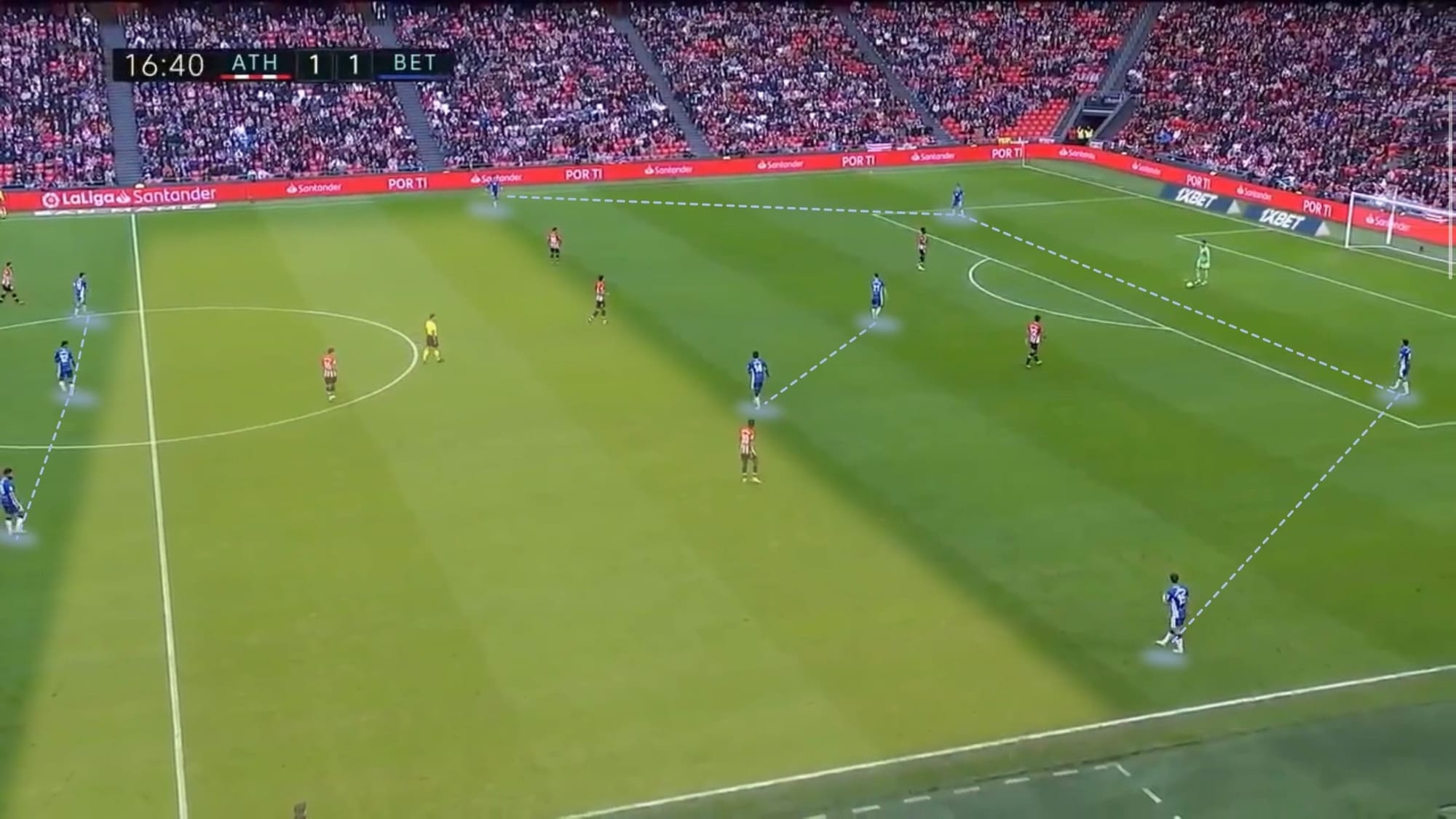
The common denominator in these approaches is how close the forward players remain to each other, and the fluidity of their movement. It isn’t only Fekir and Canales that have free reign, it’s the centre forward and left midfielder too. These four positions, and how they interact with each other, are fundamental to how Betis progress the ball through the lines.
In established possession – the four amigos
Typically we’re talking about four players here. Fekir, Canales, Juanmi and Willian José (or Borja Iglesias – the centre forwards have shared pitch time).
On paper, there are two wide forwards, a number 10 and a centre forward. In reality, each of them will play all of those positions in the same game.
The fluidity, interchanging and passing combinations between these four are what makes Real Betis so exciting. We’ve talked about Fekir and Canales dropping deep, but they’re just as frequently running beyond the back line. And while Juanmi and José are the usual runners in behind, they’re equally comfortable dropping deep.
Take any two attacking moments from Betis and they’ll look different. Here, Fekir is on the left, playing a one-two with Canales on the edge of the box. Meanwhile, José and Juanmi attack the area.
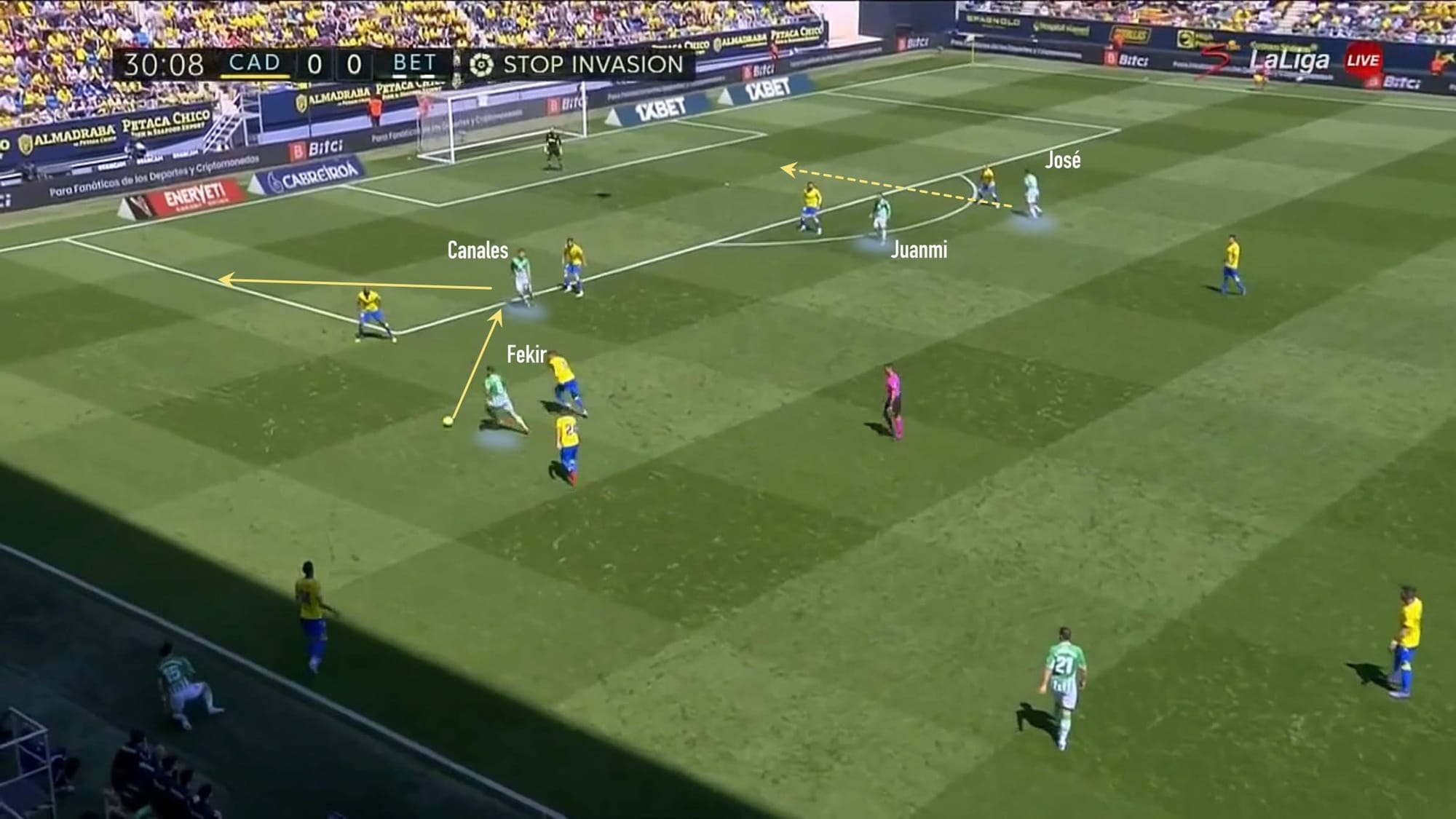
A few minutes later, José has come deep to receive, Canales runs into the box, while Juanmi hugs the left touchline (out of the picture).
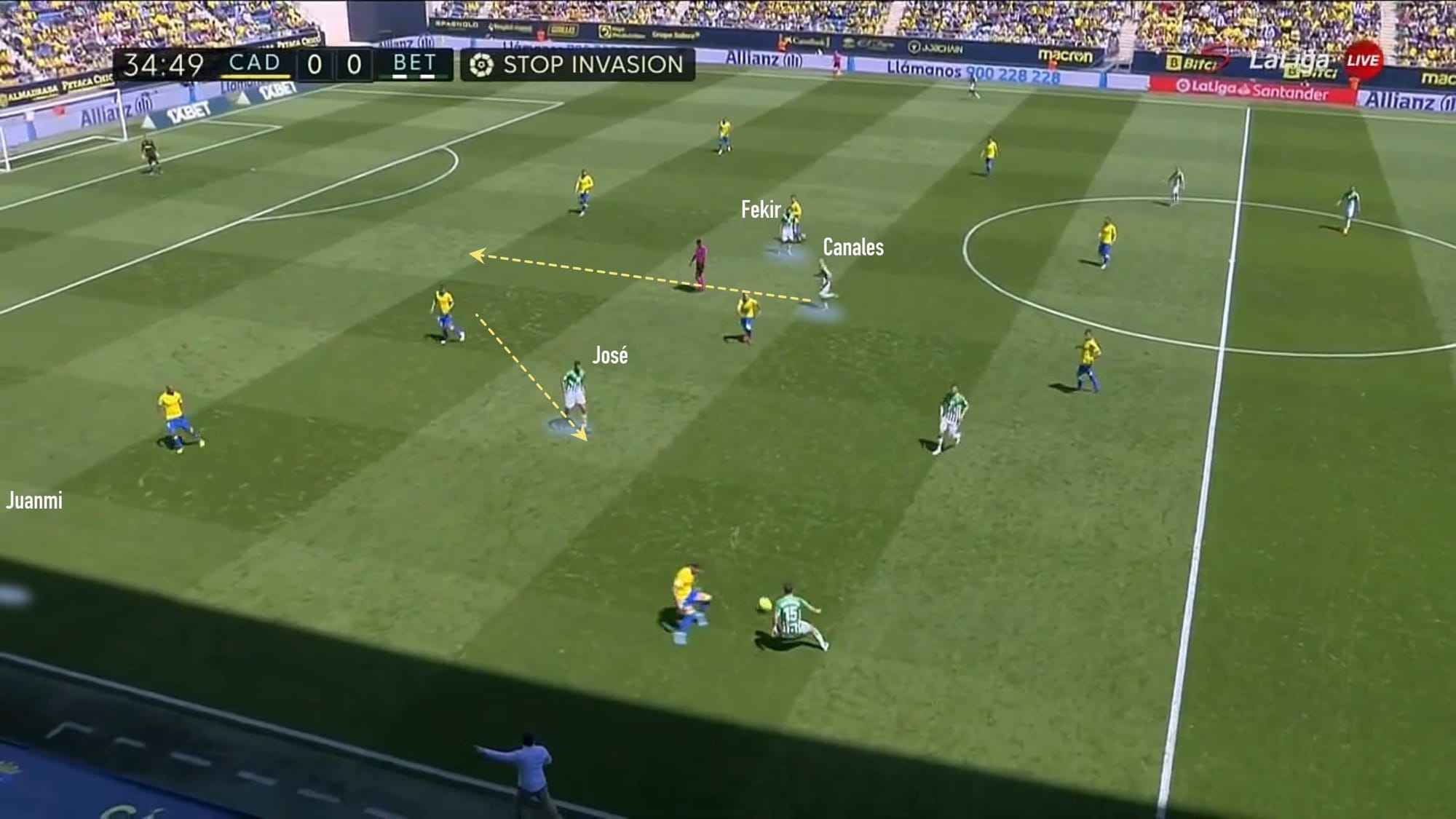
While it may look like complete chaos, there are some guiding principles that make this movement so seamless and effective.
1) Players work in close proximity – this means that the wide forwards (particularly Juanmi) rarely ever stay wide. As soon as Betis progress the ball, the forwards take up central positions, close to each other, so they can combine and overwhelm the opposition.
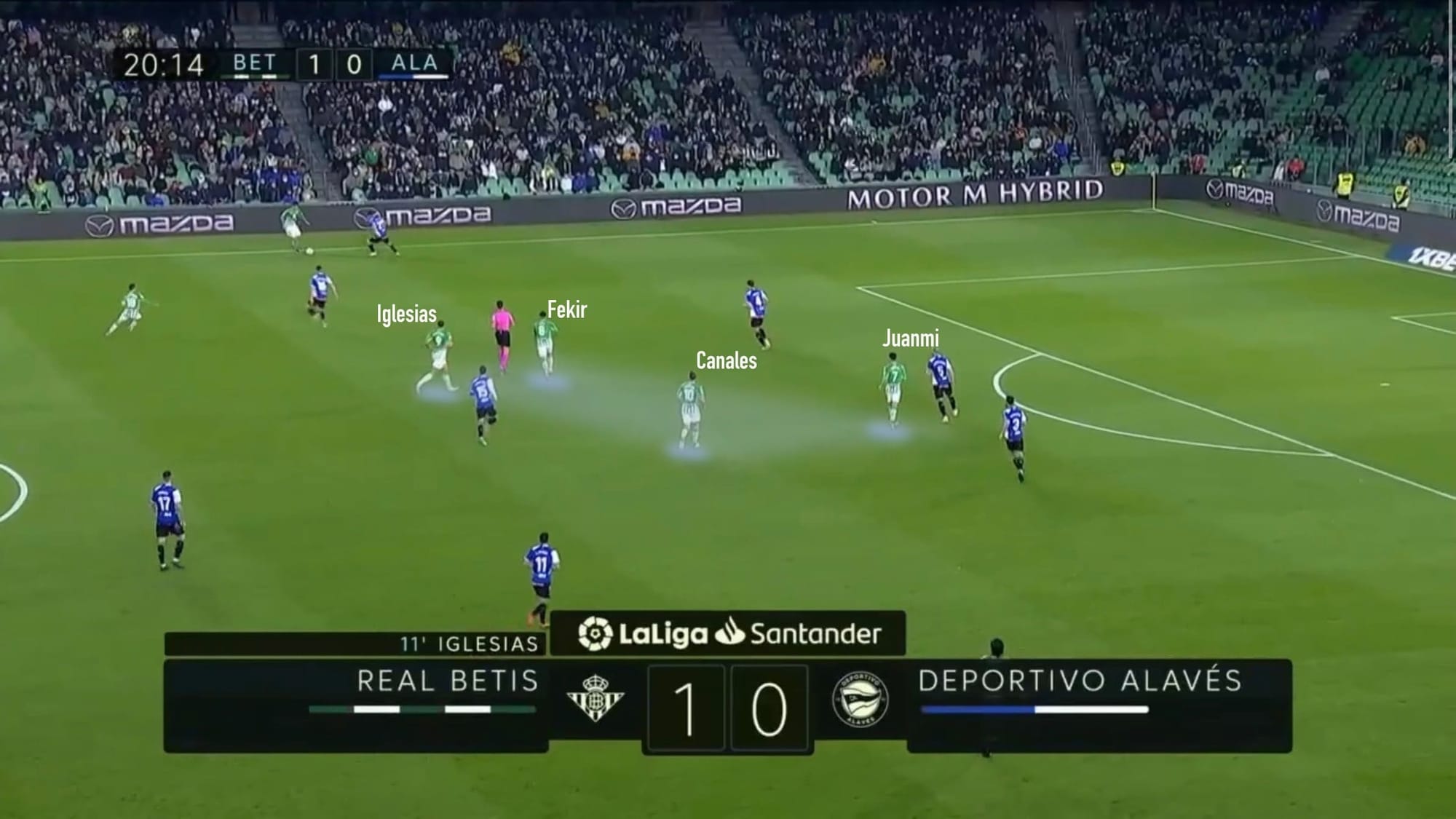
2) Pass and move – the central tenant of possession football, this principle is so often forgotten even at the highest level. But for Betis, it’s second nature.
3) Runners in behind – progressing the ball requires forward runs. As good as Betis can be at maintaining possession, their tendency to break forward and play risky balls in behind is what sets them apart in La Liga. In this example, Fekir progresses the ball from deep and immediately sets off on a run in behind the defence.
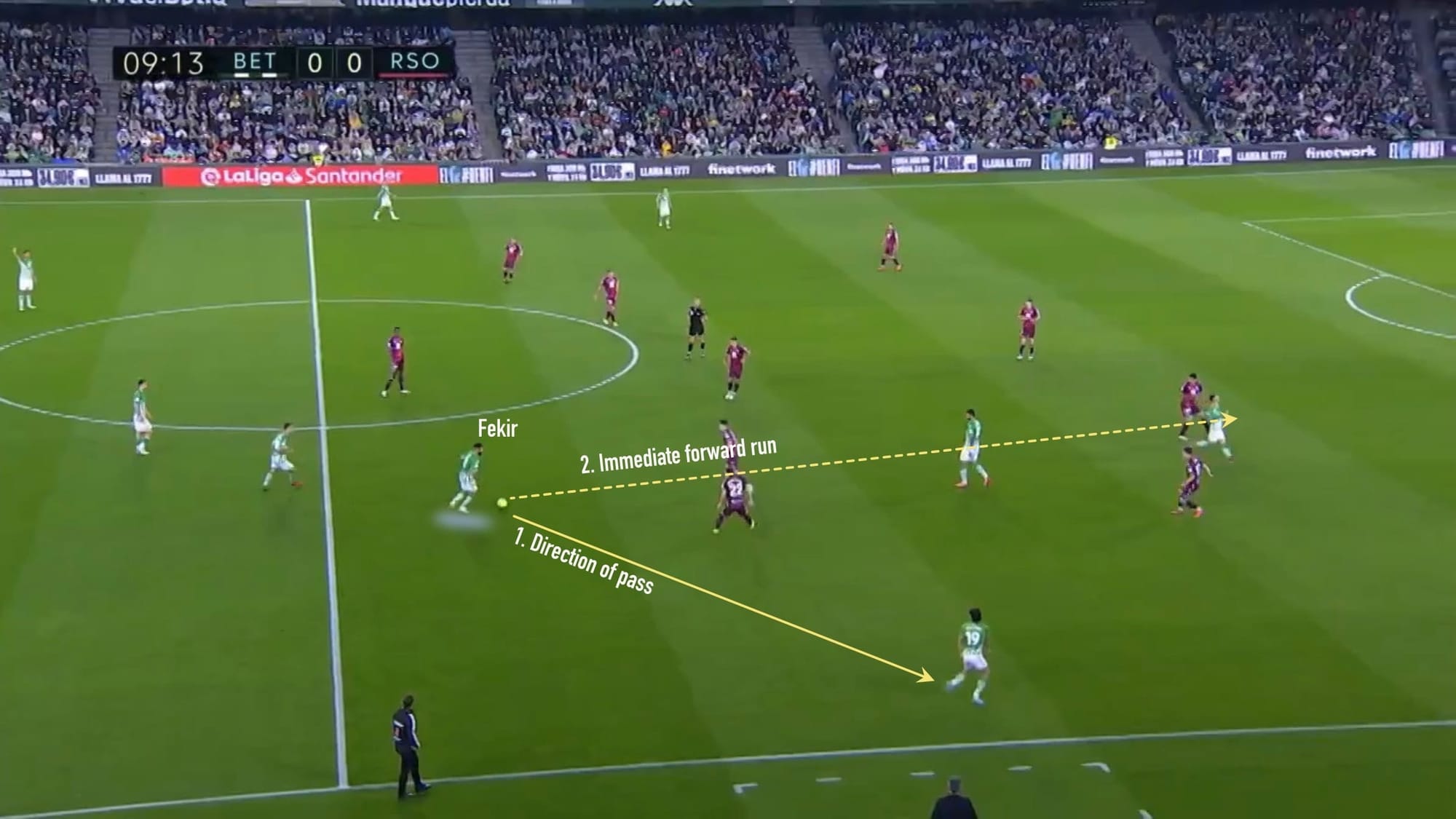
The result of all of this is, as you may have guessed, some aesthetically majestic goals.
Defensive philosophy – constant aggression
As much as they’ve been praised for their offensive fluidity, Betis’ season was made possible by maintaining a solid defensive record. How they did this, though, was in keeping with the same proactive philosophy as their attacking play.
You might expect a 4-2-3-1 to be built on a solid, consistent defensive structure. But for Betis, it isn’t the case.
At times, there is a semblance of a 4-2-2 shape, as you can see here. Narrow, with minimal space between the lines.
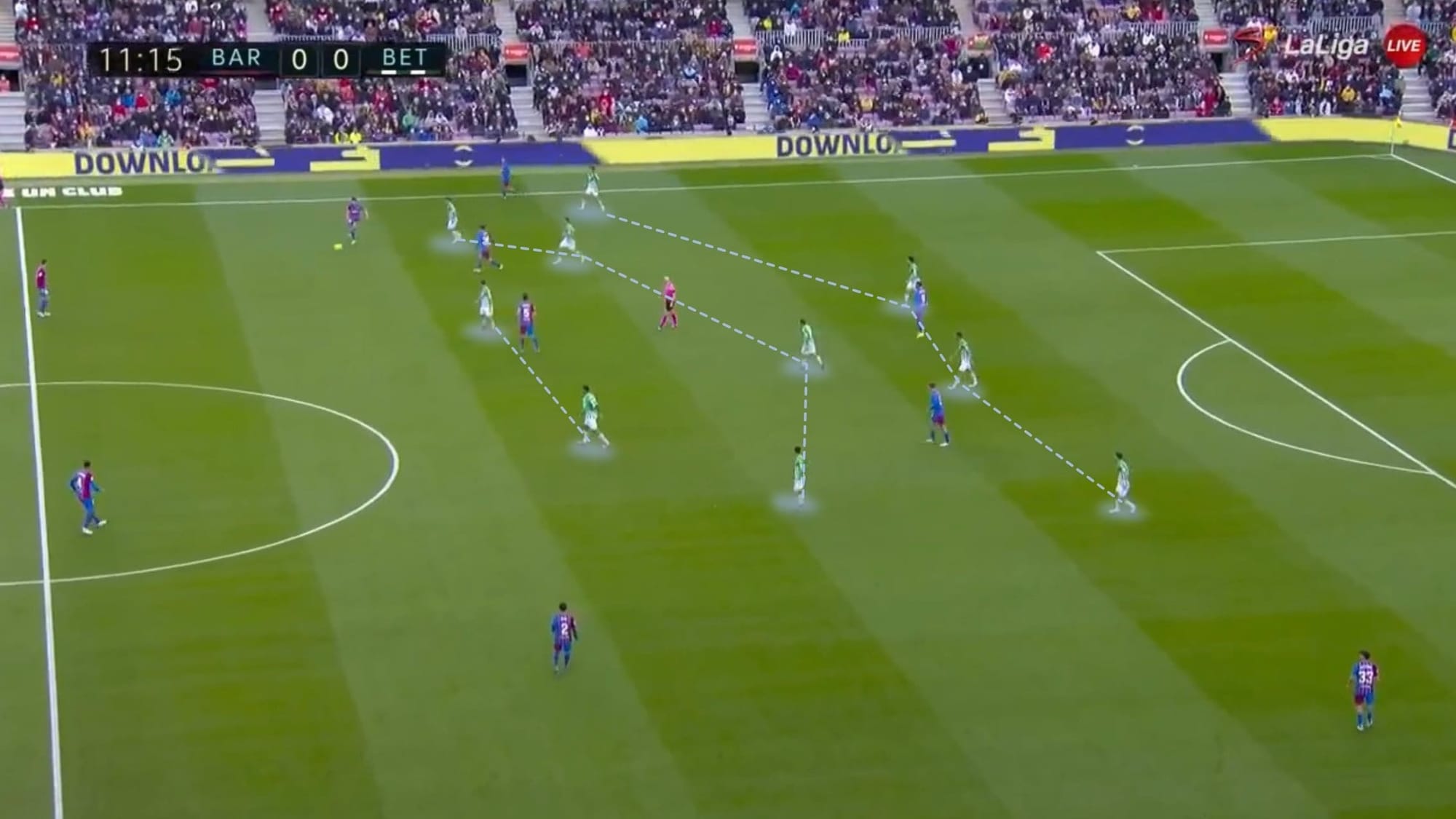
However, this shape is purely situational. For the vast majority of most games, Betis deploy an aggressive man-to-man press, aiming to prevent any comfortable possession for the opponent.
If the opponent is playing with two centre-backs, Betis will press both. If that leaves them outnumbered in midfield, one of the centre-backs can step up to apply the necessary pressure.
While this again may feel like chaos, it’s important for Betis’ press to be coordinated and disciplined. For example, it’s not just enough to close down a player but simultaneously block the passing lane forward. As Ruibal does here.
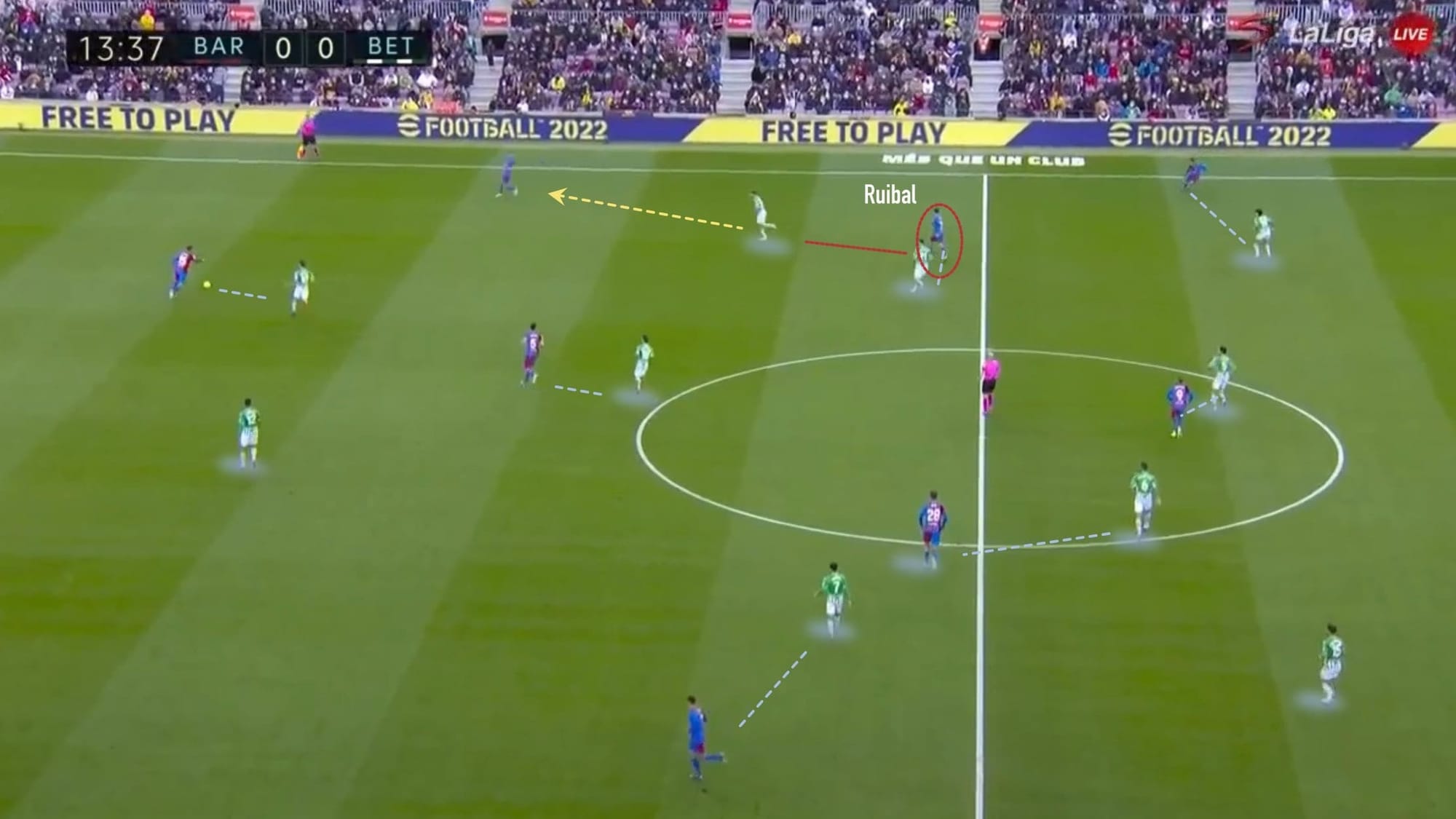
This allows Betis to force the opponent back, moving as a unit to prevent easy possession. Even against Barcelona, the league’s premier possession side, they kept up the same aggressive pattern up for most of the game.
What makes Betis’ philosophy different from a lot of high-pressing teams is that they are looking to win the ball outright, rather than just to force a long ball. This is why, for example, both centre-backs are pressed instead of just one of them. Despite being one of the better possession-based teams, Betis also rank highly for tackles and interceptions (7th highest). Other teams that see a lot of the ball, such as Barcelona, Real Madrid and Sevilla all rank 13th or below for the same metric.
Counter-press and struggles in transition
Of course, there is more to Betis’ defensive strategy than man-to-man pressure. With such an emphasis on direct chance creation, it’s important that they do not regularly concede the ball and suffer from transitions.
As you’d probably expect, Betis deploy an aggressive counter-press to try and negate that.
Typically this means both defensive midfielders are stationed on the edge of the box. Often, if the ball is wide, the opposite full-back will also come narrow, as shown below.
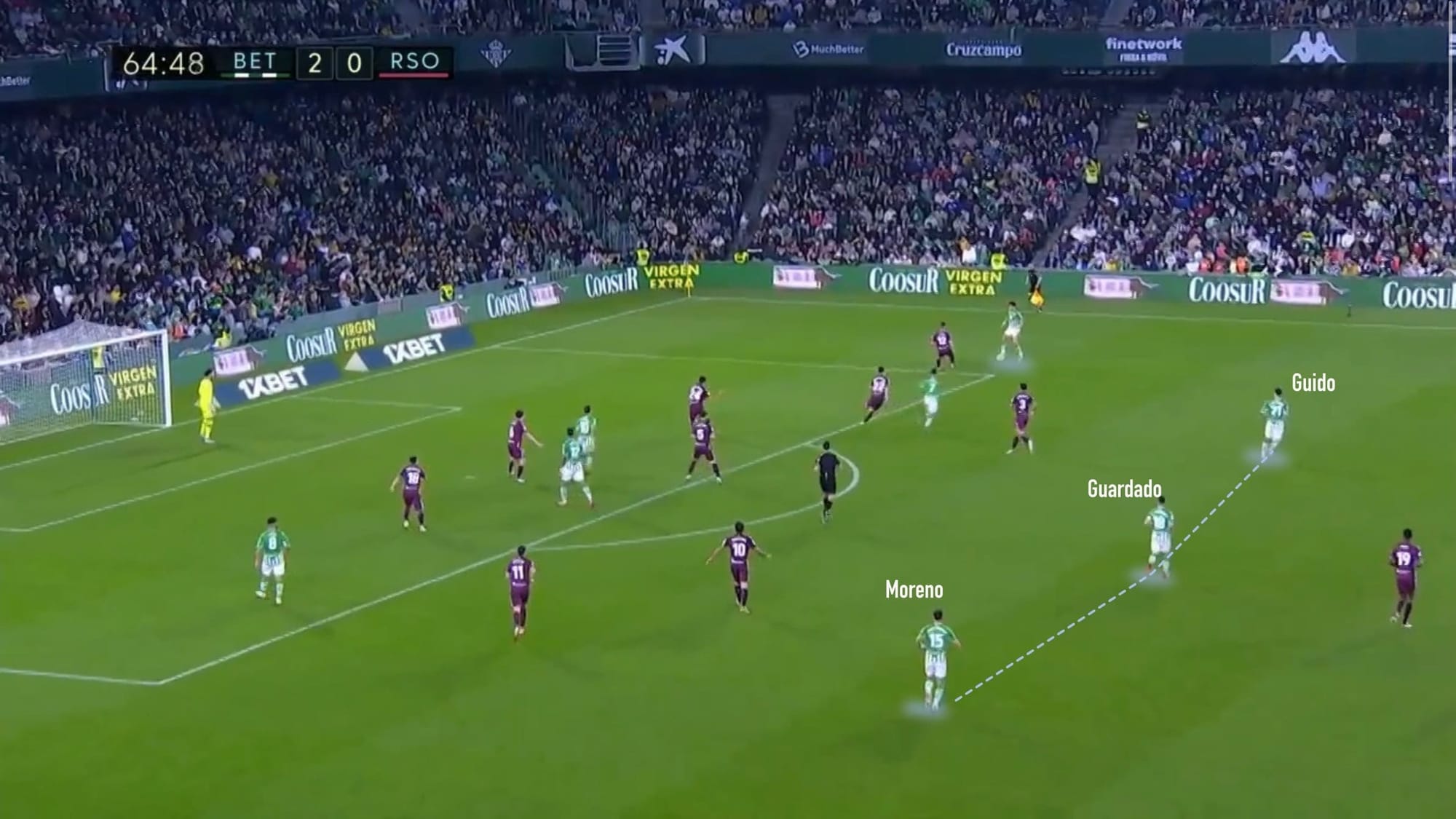
In this case, if the attack breaks down there is plenty of cover to prevent a transition. This shape has been very effective for most of the season.
However, things don’t always go to plan. Because Betis are so fluid and direct in attack, there isn’t always this level of cover behind the ball when it breaks. Or, as alluded to earlier, there is a chasm between the attack and defence that can be exploited.
Here, it only took one long ball to create a four versus four scenario. The defensive midfielder simply has too much ground to make up.
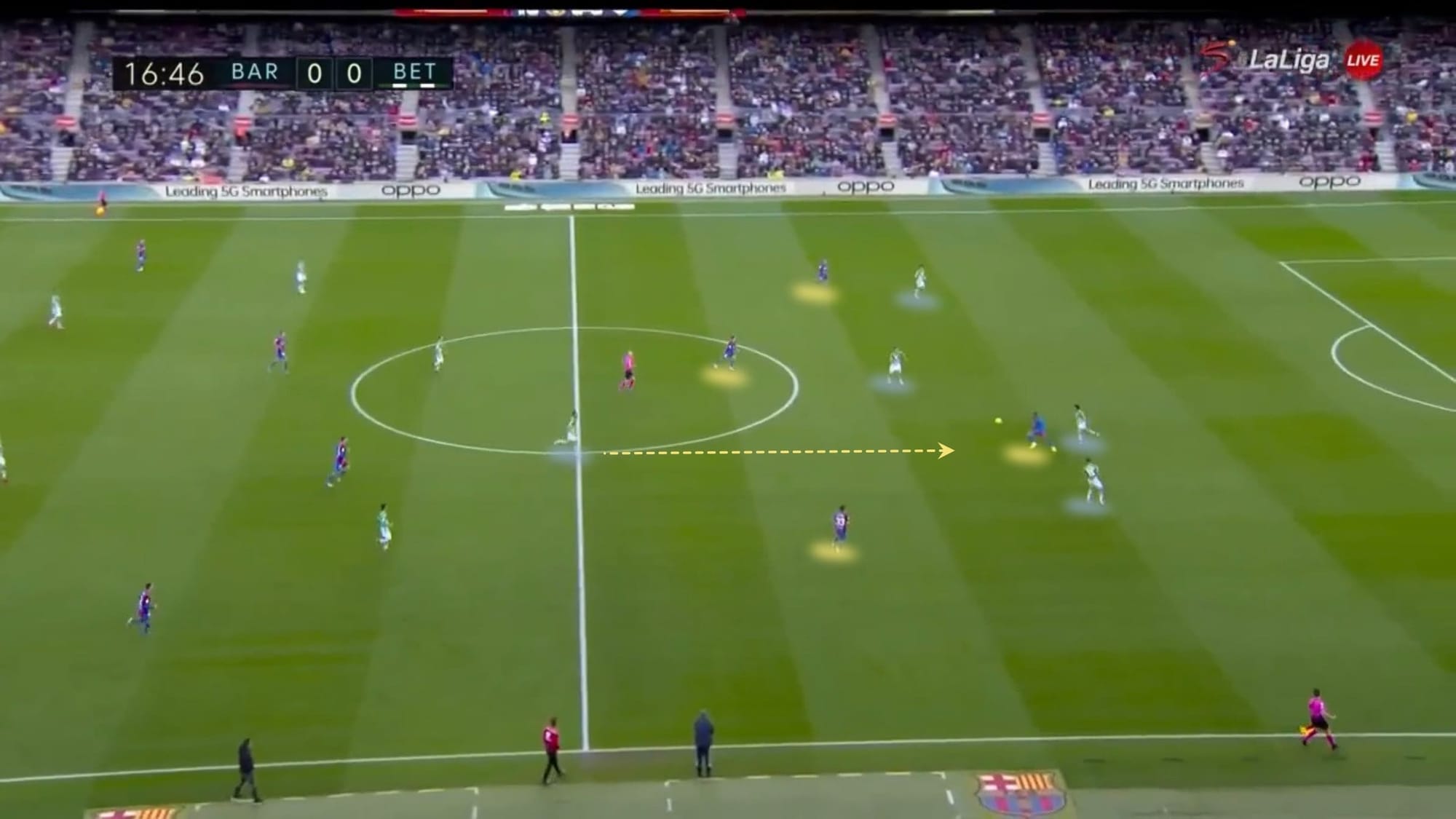
Betis’ high-risk defensive philosophy has, on some occasions, cost them important points.
Against Athletic Bilbao for example, at 2-1 up, they continue to press man-to-man. There’s a gaping hole in the middle of the pitch, and their defence is in a four versus four situation.
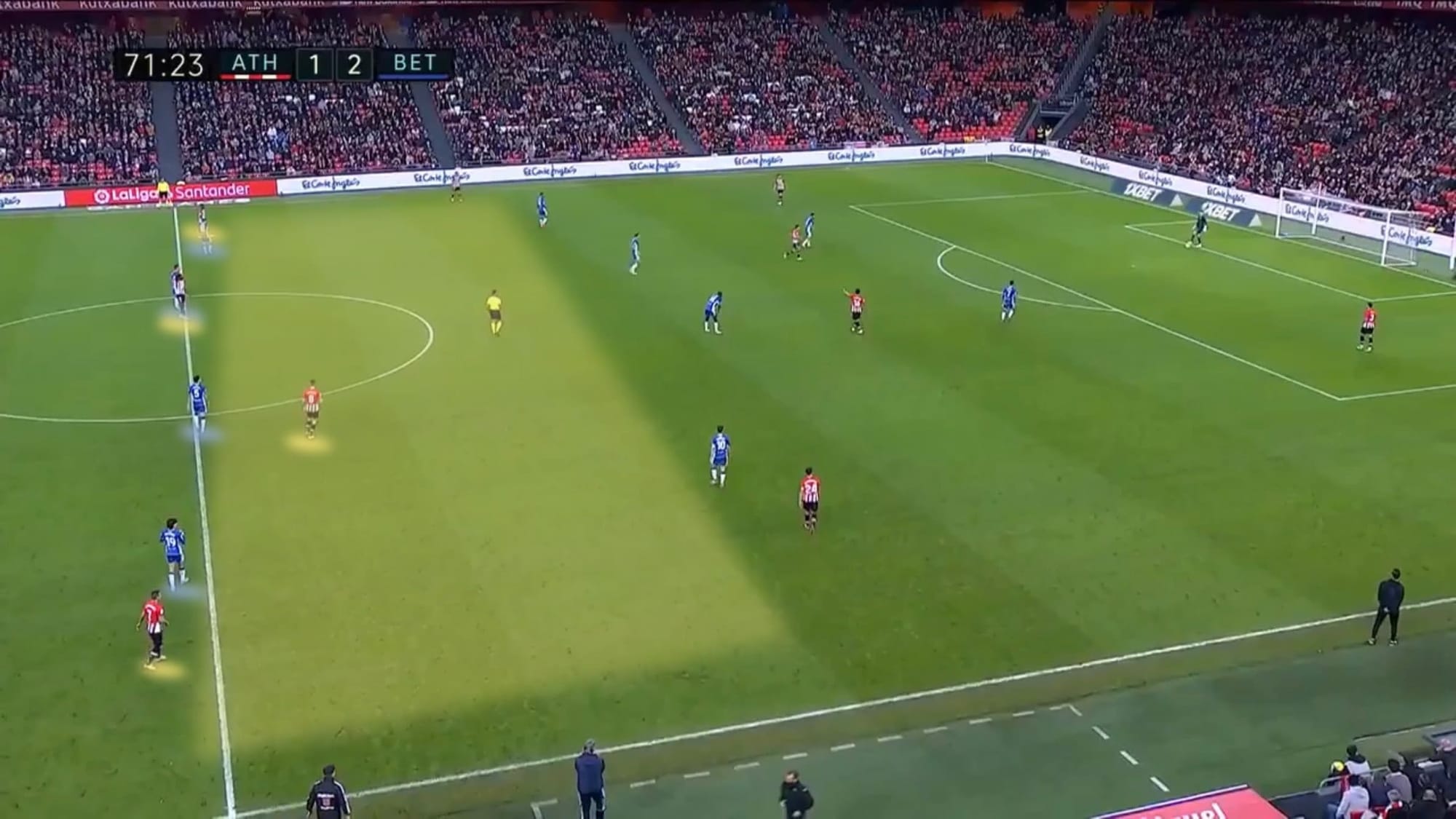
Most teams here would take one of two routes. Either 1) defend with the ball, keeping possession at all costs, or 2) sit back in a solid defensive shape. Betis do neither. Instead, they maintain their direct attacking football, hoping to score a third goal in transition. They also continue to press aggressively regardless of game state and opponent.
As a result, gaps appear, and they are in no control of the game. Against direct opponents who are happy to bypass the press (as Athletic are), they are vulnerable. They lost this game 3-2.
Conclusion – a squad performing at its maximum
Pellegrini’s Real Betis are entertaining, effective and surprisingly consistent. It’s a squad of very talented players, almost all of which are in their prime. Their combination of quality, experience, and freedom has been the recipe for a monumental season. But not all is perfect.
For one, it’s a small squad. And while it has the experience, it’s sorely lacking in youthful prospects that can improve the team in the coming years. It’s a miracle, in fact, that Pellegrini made this squad competitive in three competitions. While the starting eleven isn’t exceedingly old (Canales is generally the oldest at 31), the team still relies on important squad players like Andrés Guardado, who at 35 is certainly getting on.
One of the prerequisites for a top-four challenge, then, will be refreshing the squad. All of the sides above them certainly will be.
The other is simply that the team becomes more pragmatic. Particularly from a defensive perspective. While their bravery and commitment to their philosophy are commendable, there will be times when they need to adapt if they want to make up those five points on Sevilla.
Frankly speaking, securing Champions League football will be a big ask for Betis. Despite their undoubted talent and unique tactical setup, they are competing against teams with much bigger budgets and far deeper squads. While they can beat anyone in a one-off game, remaining consistent while fighting on three fronts will require a huge effort. Possibly, it’s too much to ask.
But for the neutral, they will certainly remain one of the best teams to watch. If Pellegrini and co can deliver on the entertainment again, and if they can clinch another Europa League place, that will still be a major success.






Comments